10 Google review response templates to manage positive & negative reviews ⭐

Weronika
November 5, 2024
|
Online reviews hold serious power. They influence how people view your brand and even determine whether someone decides to do business with you. That’s why responding to Google reviews isn’t just a polite gesture but rather a strategic move that can significantly impact your brand reputation and drive more conversions.
A thoughtful, well-crafted response shows that you genuinely care about your customers and are willing to engage openly—whether the feedback is glowing praise or constructive criticism.
Of course, managing a constant influx of reviews can get overwhelming… That’s where using response templates becomes a game-changer. They save you loads of time, especially for quick or non-descriptive reviews, while still letting you deliver quality responses. You can keep your brand voice consistent and maintain a professional image without spending hours typing out each reply.
That’s where Center AI comes in. As a leader in reputation management tools, Center AI makes it easy to keep up with all those reviews so that you can stay responsive, polished, and on top of your online presence. Keep reading, because in this article we’re sharing 10 (!) Google review response templates to help you effortlessly manage both positive and negative feedback while still connecting with your customers in a meaningful way.
The value of responding to reviews
Impact on conversion rates
Responding to reviews has a powerful influence on your conversion rates. In fact, businesses that engage more actively with managing their reputation, earn 58% more revenue. Why? Because taking the time to respond, whether to a glowing review or a critical one, builds trust.
Also, another research indicates that businesses responding to reviews experience an 80% increase in conversion rates compared to those that get neutral reviews or don’t. Potential customers see that you genuinely care about your clients’ experiences, making them more confident in choosing your business.
This sense of reliability and authenticity can be a major factor in turning casual browsers into loyal customers.
For deeper insights, explore our guide on 25 must-know online reputation statistics to understand how reviews directly impact customer behavior and conversion.
SEO benefits
Engaging with reviews and review sites isn’t just about customer relations but it also has tangible SEO advantages. Google factors in review activity as part of its local ranking criteria.
When your business frequently responds to reviews, it signals to search engines that you are an engaged, credible entity among local businesses. This can improve your rankings in local search results, making your business more visible to people in your area who are searching for the products or services you offer.
In other words, active review management isn’t just good for your reputation—it’s a smart move for your local SEO strategy.
Want to make sure your reviews and profile are fully optimized for local search? Get a free Google Business Profile audit to uncover insights, improve rankings, and stay ahead of competitors.
Speed that brings trust
Speed is everything when it comes to reviewing responses. The faster you reply, the more your business stands out as responsive and customer-focused. Studies show that businesses responding to reviews within 24 hours are more likely to retain clients and attract new ones.
A quick response shows that you prioritize your buyers and are serious about addressing feedback, whether positive or negative. Responding quickly to negative reviews, in particular, can help de-escalate issues and show your commitment to making things right.
Remember, timeliness doesn’t just boost your online reputation—it can also turn a potentially negative experience into a chance to win back people’s trust.
When to use and avoid review response templates
Crafting the perfect response to a Google review can be tricky. While templates are a great way to save time and maintain consistency, there are definitely moments when a more personal touch is needed. Let’s break down when templates are your best friend—and when they’re not—to make sure your responses always hit the right note.
When templates shine ✨
Templates are fantastic for your efficiency, especially when you’re dealing with short, star-only, or non-descriptive reviews. For example, if someone leaves a 5-star rating with no accompanying comment or a simple “Great service!” your response doesn’t need to be overly customized.
A polished template that expresses gratitude and lightly reinforces your brand message can do the job perfectly. Templates are also helpful for managing volume—when your team is juggling hundreds of reviews, having a consistent yet friendly reply ready to go can make a huge difference.
Scenario where templates work well:
Review: ⭐⭐⭐⭐⭐ (No additional comment)
Positive review response examples:
- “Thank you so much for the 5-star rating! We’re thrilled you had a great experience and look forward to serving you again soon.”
- “Thank you for the 5-star review! We truly appreciate your support and hope to see you again soon!”
- “Your 5-star rating made our day! We’re so glad you had a positive experience. Looking forward to your next visit!”

Review: “Loved the food!”
Positive review response examples:
- “We’re so glad you enjoyed your meal! Thanks for sharing your experience and for choosing us. We can’t wait to welcome you back!”
- “Thank you for dining with us and loving the food! Your kind words mean a lot, and we’re excited to serve you again!”
- “We’re delighted to hear you enjoyed your meal! Thank you for the kind review, and we hope to welcome you back for more deliciousness soon!”
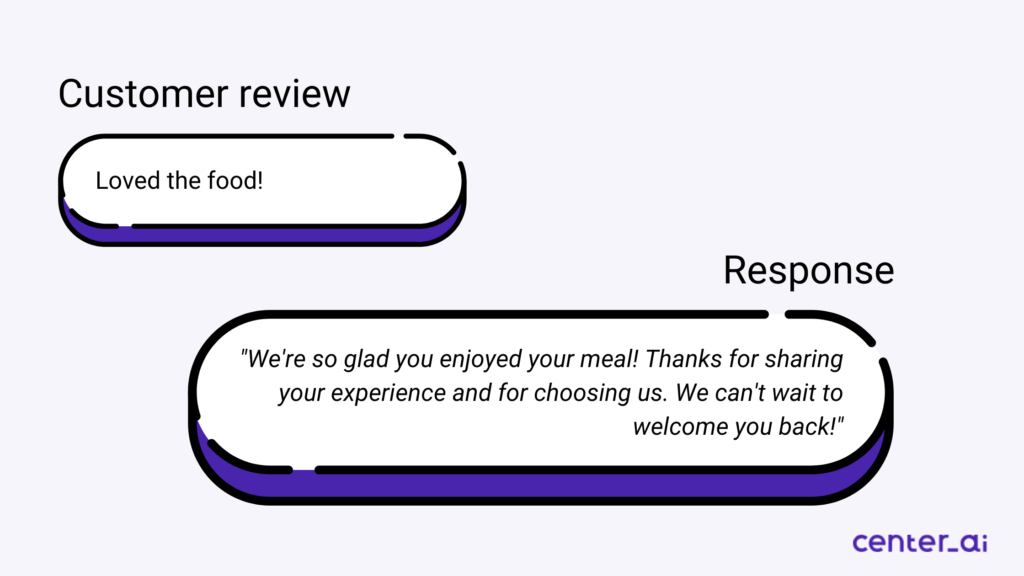
A template is perfect in these cases because it acknowledges the review without needing a personalized touch.
When to skip templates ❌
On the flip side, templates should be avoided for detailed or emotionally charged reviews. When a customer leaves an in-depth comment—whether they’re raving about an amazing experience or outlining a serious complaint—a customized, empathetic response should be your way to go.
Copy-pasting a generic template in these situations can come across as tone-deaf or insincere, potentially damaging your brand’s reputation. A customized reply lets the reviewer know you genuinely care about their specific feedback and are committed to addressing it.
Scenario where templates should be avoided:
Review: “The staff was incredibly friendly, and the ambiance was perfect. However, I had an issue with my order: it arrived late and was missing items. The manager was kind but didn’t fully resolve my concern.”
Appropriate response:
- “Thank you for taking the time to share your experience. We’re delighted to hear that you enjoyed our atmosphere and staff, but we are truly sorry about the mishap with your order. Your feedback is valuable, and we’ll be addressing this with our team so that it doesn’t happen again. Please feel free to reach out so we can make it right.”
- “We really appreciate your kind words about our staff and ambiance. However, we sincerely apologize for the inconvenience you experienced with your order. It’s important to us that every guest has a seamless experience, and we’re sorry we let you down. Thank you for bringing this to our attention, and we’d love the opportunity to make things right.”
- “Thank you for highlighting both the positives and the areas where we need improvement. We’re glad you enjoyed the atmosphere and our friendly staff, but we are deeply sorry about the issues with your order. We’ll use your feedback to ensure we enhance our service. If you’re open to it, we’d be happy to discuss how we can make up for this.”
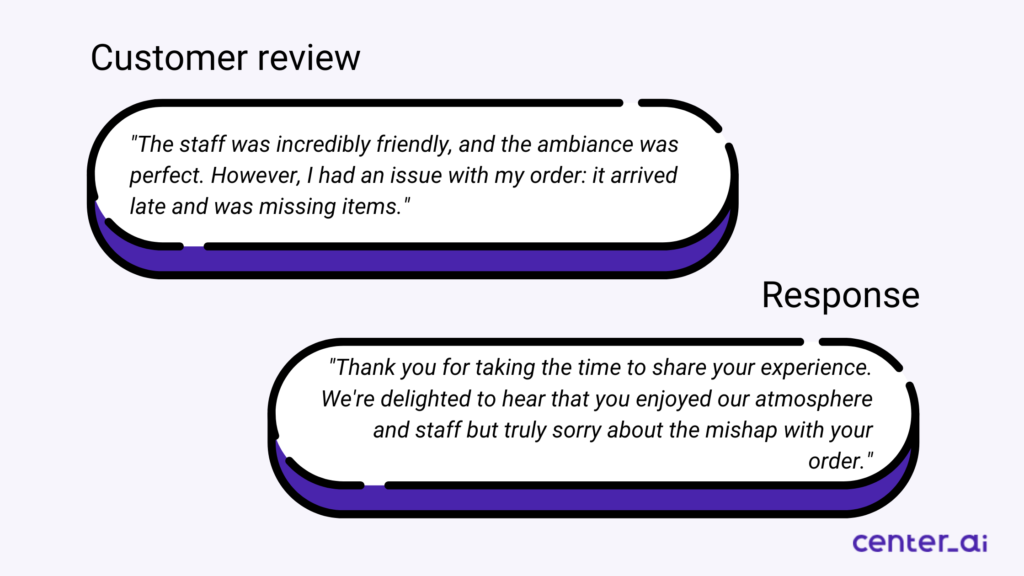
Review: “Terrible service. We waited 30 minutes just for someone to take our order. Won’t be coming back.”
Appropriate response:
- “We apologize for the long wait and the frustration it caused. We aim to provide timely and attentive service, and it’s disappointing to hear we fell short. Please know we’re taking your feedback seriously to improve our process. If you’d like to discuss this further, we’d love the chance to make it up to you.”
- “We’re truly sorry for the unacceptable wait time and the impact it had on your experience. Our goal is to provide efficient and friendly service, and it’s clear we missed the mark. Your feedback is necessary, and we’re committed to making changes. Please consider giving us another chance to serve you better.”
- “It’s disappointing to hear about the delay you faced and the negative impression it left. We deeply regret not meeting your expectations and want to ensure this doesn’t happen in the future. Thank you for your honest review, and if you’re willing, we’d love the opportunity to discuss how we can earn back your trust.”
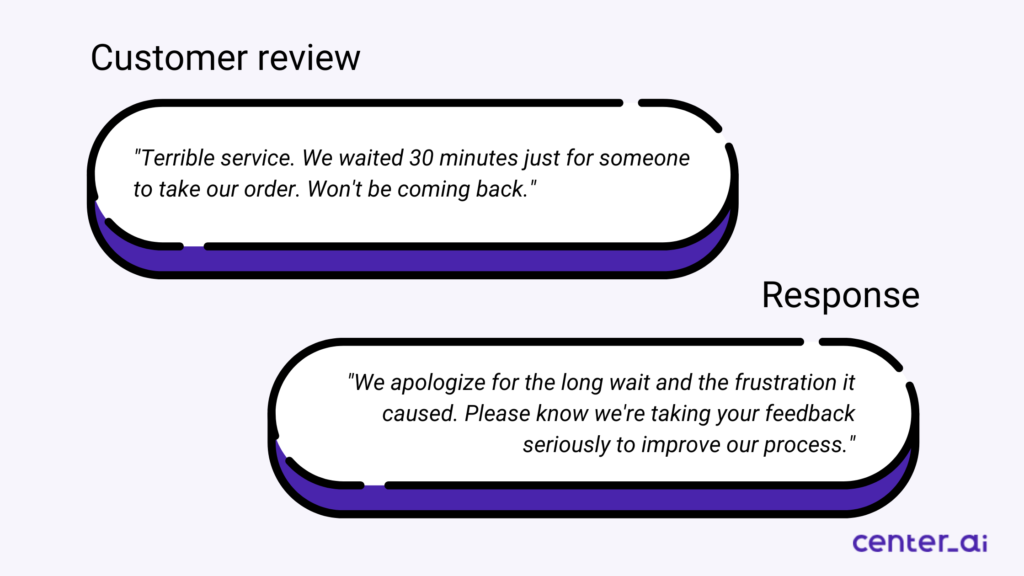
In such cases, as a business owner, take your time to craft a genuine, thoughtful reply. It shows that you’re listening, taking responsibility, and willing to take action to improve.
10 essential Google review response templates
Responding to Google reviews effectively can shape your brand’s reputation and build strong customer loyalty and relationships. Here are 10 response templates to help you handle a wide range of review situations.
Template 1: Responding to a 5-star review without text
When a client leaves you a 5-star rating but doesn’t write any additional comments, it’s still important to acknowledge and show appreciation for their support.
Example response:
“Thank you so much for the 5-star rating! We’re thrilled to know you had a great experience. If there’s ever anything we can do for you, just let us know. We look forward to serving you again!”
Why templates work well here:
When there’s minimal information, a short, simple response shows you value their rating while keeping the interaction positive.
Managing multiple reviews simultaneously can be streamlined using Center AI’s Review Response Manager. This tool allows you to view and respond to all your reviews from a single dashboard, saving time and effort.

Template 2: Responding to a 5-star review with a detailed message
When a valued customer writes a glowing review with specific details, your response should be equally thoughtful and engaging.
Example response:
“Thank you, [Name], for sharing such a detailed and wonderful review! We’re delighted to hear you enjoyed [specific product or service]. Your kind words mean a lot to our team, and they motivate us to keep doing our best. We can’t wait to welcome you back!”
How to add a personal touch:
Mention specific elements of their feedback to make your response feel genuine and adjusted.
Template 3: Responding to positive feedback in a formal tone
Sometimes, a more professional tone is needed, especially if the review comes from a business client or in a more formal context.
Example response:
“We sincerely appreciate your positive feedback. It’s rewarding to hear that our efforts to our customer support team deliver exceptional service met your expectations. Thank you for choosing [Company Name], and we look forward to our continued partnership.”
When to use formal language:
This approach works best when addressing business clients or when your brand image requires a more professional tone.
Template 4: How to respond to positive reviews
A laid-back, conversational tone can make your brand feel approachable and friendly.
Example response:
“Wow, thanks so much for the awesome review! We’re so glad you enjoyed [specific service/product]. You totally made our day, and we can’t wait to have you back!”
Benefits of a relaxed, friendly tone:
A casual response can help your brand feel more relatable, especially if your audience is younger or appreciates a fun vibe.
Center AI’s platform allows you to manage multiple profiles on Google, Bing, and other platforms, ensuring consistent and friendly communication across all channels.
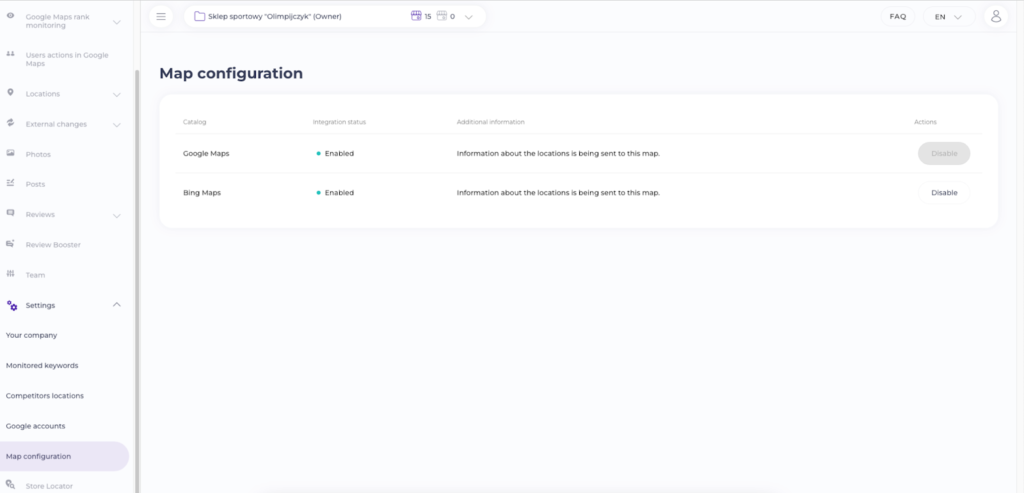
Template 5: Using humor in a positive review response
If your brand is known for being playful, humor can be a great way to engage with positive feedback.
Example response:
“Thanks a million for the fantastic review! We’d love to say we do cartwheels every time we get feedback like this… but we’re still working on our flexibility. Come visit us again soon!”
When humor is appropriate:
Use humor sparingly and only if it aligns with your brand’s personality. Avoid humor in sensitive contexts or when it could be misunderstood.
Center AI’s AI-supported Review Booster tool helps you generate reviews, allowing you to focus on crafting engaging and on-brand responses.
Read more on the Review Booster

Template 6: Addressing a short negative review (for example, just 1 star with no comment)
Sometimes, dissatisfied customers give a low rating without providing any additional information or explanation as to why they are dissatisfied. This can be frustrating because it’s difficult to understand exactly what went wrong and take the appropriate steps to fix it or improve your services.
Example response:
“We’re sorry to see your 1-star review and wish we knew more about what went wrong. Please feel free to reach out to us directly so we can understand your concerns and make things right.”
How to maintain professionalism:
Stay calm and polite, inviting the reviewer to provide more details so you can address the issue constructively.
Center AI’s platform allows you to monitor and analyze customer ratings, helping you identify areas for improvement and address negative reviews promptly.
Template 7: Empathetic response to detailed negative reviews
When someone points out a specific problem in a review, it’s good to respond with empathy and understanding. It’s a good idea to show that you really care about their experience and offer a concrete solution. This kind of response builds trust and shows that your brand cares about your customers and wants to keep evolving.
Example response:
“We’re truly sorry to hear about your experience, [Name]. We understand your frustration and would love the opportunity to make it right. Our team has already reviewed your concerns and is working on a solution. Please contact us at [contact info] so we can discuss how to better serve you in the future.”
Tips for showing understanding and offering solutions:
Acknowledge the issue, express genuine concern, and offer a way to resolve the problem. This shows your commitment to improving.
Center AI’s automated categorization and sentiment analysis of reviews help you understand buyers’ concerns and respond appropriately.
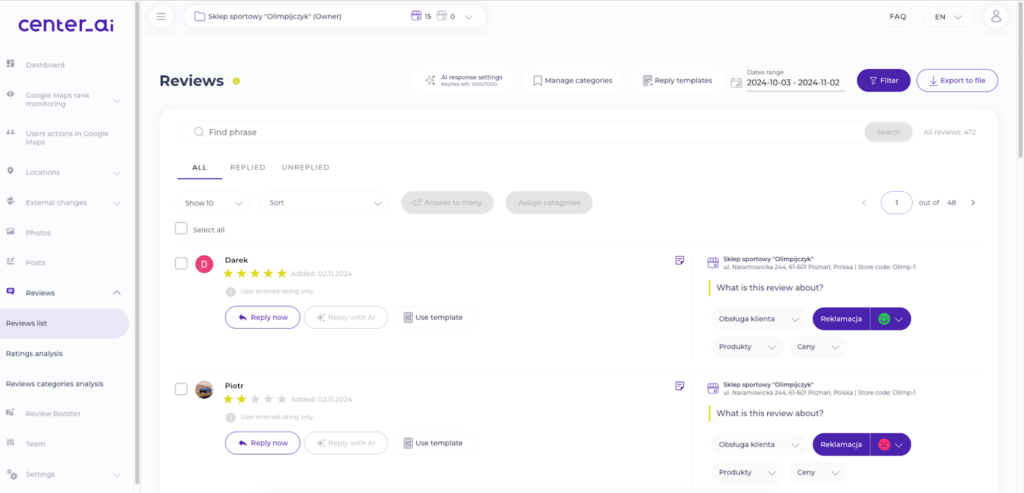
Template 8: Responding to a fake or unfair review
Fake or misleading reviews can be tricky, but your response to bad reviews should remain composed and factual.
Example response:
“We take all feedback seriously and strive to ensure our clients have the best experience possible. However, we’re unable to locate your record in our system. Please reach out to us so we can better understand your concerns and address them properly.”
Approach to handling misleading feedback calmly:
Stay factual and professional, and avoid getting defensive. Flag the review for removal if it violates Google’s policies.
Center AI’s platform helps you monitor reviews from various sources, allowing you to identify and address fake or unfair reviews effectively.
Template 9: Converting a negative experience into a positive outcome
A negative feedback from an unhappy customer? It’s actually a chance to show how much you care about the customer satisfaction. Take advantage of it!
Example response:
“Thank you for sharing your concerns, [Name]. We’re sorry to hear about your experience and truly appreciate your valuable feedback. We’ve taken your comments to heart and made improvements to prevent this from happening again. We hope you’ll give us another chance to show you our commitment to excellence.”
Strategies for turning a complaint into brand growth:
Show how you’ve learned from the feedback and outline the steps taken to improve, inviting the client back to experience the change.
Center AI’s AI reporting provides insights into customer sentiment, helping you make informed decisions to advance satisfaction.
Template 10: Thanking a customer for constructive feedback
Constructive criticism can be valuable for growth, and acknowledging it shows your appreciation.
Example response:
“Thank you for your honest feedback, [Name]. Your insights are invaluable and help us improve excellent service. We’re working on implementing your suggestions and look forward to providing you with a better experience next time.”
How to appreciate feedback for improvement:
Highlight the positive impact of their feedback and express your commitment to using it for growth.
Center AI makes it easy to track and respond to constructive customer feedback, too. By using automated follow-ups and notifications, you can guarantee that important suggestions from potential customers don’t slip through the cracks.

Different communication styles in review responses
When responding to Google reviews, the tone you use can greatly impact how your message is received. Adopting the right communication style for your audience is essential, as it can strengthen your brand’s connection with customers.
Let’s examine three common communication styles—formal, casual, and humorous—and explore when to use each.
Formal style
A formal, professional tone is best suited for industries where trust, reliability, and expertise are keystones, such as law firms, healthcare providers, or financial institutions. This communication style conveys respect, seriousness, and a high level of excellent customer service. You might also use a formal approach if the review addresses a particularly sensitive or complex issue that requires careful handling.
Example response: “Thank you, Mr. Smith, for sharing your feedback. We truly appreciate your kind words and are pleased to hear that you had a positive experience. Our team is committed to providing exceptional service, and your comments reaffirm the hard work we put into our business. Should you require any further assistance, please do not hesitate to reach out.”
Tips for using a formal tone:
- Keep the language structured and polished.
- Address the reviewer by name and use respectful titles when appropriate.
- Focus on clarity and professionalism without sounding too stiff.
Casual style
Using a casual, friendly tone can make your brand seem approachable and relatable. This style works well for businesses in hospitality, retail, or entertainment, where a personal connection can be a competitive advantage. A casual tone shows warmth and sincerity and makes it easier for customers to feel comfortable engaging with your brand.
Example response: “Hey there, thanks so much for the awesome review! We’re thrilled you loved your experience and can’t wait to see you back again soon. If there’s anything else we can do to make your next visit even better, just let us know!”
Tips for using a casual tone:
- Use simple, conversational language that feels genuine.
- Don’t be afraid to show personality or excitement.
- Avoid jargon or overly formal phrases. Instead, keep things light and engaging.
Humorous style
Humor can be a fantastic way to connect with your audience, but it requires a bit of finesse. It’s best used when your brand already has a playful, fun image or when you’re responding to light-hearted or positive feedback. Humor can make your responses memorable, but you need to be careful: it’s important to avoid coming across as dismissive, especially when addressing complaints or serious concerns.
Example response: “We’re so glad you enjoyed our coffee! We’d love to say our secret ingredient is magic, but really, it’s just a lot of caffeine and a pinch of love. Come back soon for another round—your taste buds deserve it!”
Tips for using humor in review responses:
- Know your audience! humor doesn’t always land the same way for everyone, so use it carefully.
- Keep it tasteful and light. Never use sarcasm that could be interpreted negatively.
- If the review is negative or sensitive, it’s better to stick with a more neutral or supportive tone.
By choosing the right communication style, you can tailor your review response to reflect your brand’s personality while engaging your audience.
How to customize review response templates for authenticity
When using templates to respond to reviews, take care that they don’t come across as robotic or impersonal. Customization is here to maintain authenticity and ensure your brand’s voice shines through. Here’s how to make your review responses feel genuine and tailored, even when starting with a pre-written framework.
1. Tips and tricks for customization
a. Infuse your brand’s voice
Adjust the language of your templates to reflect your brand’s personality. Are you a fun, laid-back brand? Or does your business take a more professional, formal tone? Make sure your response feels aligned with how your company communicates elsewhere. For example:
- Friendly brand: “Wow, thanks a million for the awesome review! You made our day!”
- Formal brand: “Thank you very much for taking the time to leave such a thoughtful review. We greatly appreciate your feedback.”
b. Personalize where possible
Add specific details from the review you’re responding to. If a customer mentions an employee by name or a product they loved, highlight that in your response. This shows you genuinely read and value their input.
Example: “We’re so glad to hear you had a great experience with Sarah—she truly has a gift for making our clients feel right at home!”
c. Use the reviewer’s name
Whenever possible, greet the reviewer by their name. People love hearing their own names, and this simple touch can make a big difference in how individualized your response feels.
- Instead of: “Thank you for the feedback!”
- Try: “Hi Alex, thanks so much for sharing your experience!”
d. Tailor to the review length
For short, one-sentence reviews, keep your response concise yet appreciative. For longer, more detailed feedback, write a slightly more in-depth response to match the reviewer’s effort.
e. Keep the conversation going
A little personalization goes a long way when replying to reviews. A smart ticketing system like HelpDesk pulls in customer interactions from emails, chats, and your website so you can reference past conversations and make your response feel more genuine.
If someone mentions a previous issue or question, you can acknowledge it to show you’re paying attention. If their review sounds uncertain or like they need more help, you can smoothly move the conversation to email or chat to sort things out without going back and forth in public.
2. Maintaining authenticity
a. Avoid overly formal or generic language
Phrases like “Thank you for your patronage” or “We appreciate your feedback” can feel stiff or overused. Opt for conversational and warm language that feels more human. It’s perfectly okay to be enthusiastic if a review is positive or sincerely apologetic if there’s an issue.
b. Use empathy and emotion
When responding to negative reviews, start by acknowledging the customer’s feelings. A line like “I’m sorry to hear that you had a frustrating experience” can go a long way. For positive reviews, don’t be afraid to express genuine excitement: “We’re absolutely thrilled to hear you loved it!” To learn more about how impactful reviews are on consumer decisions, check out this article on the impact of reviews on consumer purchase decisions.
c. Vary your responses
Even with templates, avoid using the exact same wording repeatedly. Rotate between a few different opening and closing phrases to keep things fresh and less predictable. For example:
- Opening options: “Thank you for your kind words!” / “We really appreciate your feedback!”
- Closing options: “Hope to see you again soon!” / “Thanks for choosing us!”
d. Review and edit before sending
Take a few seconds to review your response before posting it. Ensure it sounds authentic, addresses the reviewer’s key points, and doesn’t have any awkward or overly formal phrases. Sometimes, a small tweak—like adding a touch of humor or a heartfelt note—can make a huge difference.
By following these customization strategies, you can make even the most template-driven response feel warm, personal, and on-brand. This thoughtful approach helps reinforce your commitment to genuine customer engagement and keeps your reputation management efforts effective and human-centered.
Common mistakes to avoid
When responding to Google reviews, it’s easy to slip up and make mistakes that could harm your brand image rather than improve it. Here are some common pitfalls to watch out for and tips on how to avoid them.
1. Overusing templates
While templates are great for speedy work, over-relying on them can make your responses sound robotic and impersonal. Shoppers can tell when a response is generic, and it may leave them feeling undervalued or dismissed.
To avoid this, always personalize your template responses by mentioning the customer’s name and referencing specific details from their review. Even a small touch of customization can make your reply feel more sincere and engaging.
2. Ignoring customer concerns
A big mistake businesses often make is failing to address the content of a review directly. For instance, if a client mentions a specific issue or complaint, brushing it off or giving a generic “Thank you for your feedback” response can come across as dismissive.
Acknowledge any concerns raised and show that you’re committed to resolving them. Even if the review is positive, addressing any constructive feedback shows that you’re truly listening and care about continuous improvement.
3. Using defensive language
It’s natural to feel protective of your business, especially when faced with a negative review. However, responding defensively can make matters worse. Avoid language that shifts blame, argues with the client, or minimizes their experience. Instead, stay neutral and constructive.
Express gratitude for the valuable feedback, acknowledge the customer’s feelings, and, if needed, explain how you’re addressing the issue. A calm, professional tone can help de-escalate the situation and show that you’re committed to resolving problems thoughtfully.
Speed and automation in review management
Quick responses show your clientele that you’re engaged, attentive, and genuinely care about what they have to say. Studies indicate that 53% of customers expect businesses to reply to negative reviews within a week! People expect any business owner to be just as responsive online as they are in person. Responding promptly can turn a simple review into a strong relationship, demonstrating that your brand values feedback and acts on it.
Timeliness can be particularly impactful for negative reviews. Addressing concerns quickly and empathetically can defuse tension and even transform dissatisfied buyers into a loyal advocate. On the flip side, responding to positive reviews in a timely manner expresses gratitude and keeps your brand top-of-mind. The faster you acknowledge your clients, the stronger your bond with them becomes.
Now, keeping up with reviews and responding quickly can be a massive challenge, especially as your business scales. This is where automation comes into play. Tools like Center AI are designed to streamline the review management process, allowing you to respond swiftly without sacrificing the quality or customization of your replies.
Automation simplifies the repetitive, time-consuming parts of review management. Instead of spending hours sifting through feedback, you can use technology to sort, prioritize, and even draft responses for you. This way, your team stays focused on engaging meaningfully with customers when needed while the more routine tasks are handled seamlessly.
Automation features in the Center AI platform
Center AI takes automation to the next level with features like sentiment analysis and automated response generation. Sentiment analysis helps you understand the tone and emotional content of each positive review, neutral review, or negative review. Once you quickly identify the nature of a review, you can prioritize responses accordingly. Imagine knowing in seconds which reviews need immediate attention and which ones can wait a little longer.
Another powerful feature is automated response generation. Center AI creates personalized reply templates based on the content and sentiment of the review. These responses can then be reviewed and tweaked if necessary, but the heavy lifting is already done for you. The result? A faster, more organized process that guarantees no review goes unanswered while maintaining a human touch in your interactions.
Speed and automation aren’t about cutting corners—they’re about maximizing your ability to connect with customers while keeping your brand reputation strong.
Effortless Review Management Starts Here!
With Center AI, you can automate, personalize, and manage your review responses across platforms—all from one place.
Monitoring and analyzing response reviews
Keeping an eye on your review responses isn’t just about ticking a box! It’s a proactive approach to improving your business and staying ahead of potential issues. Monitoring reviews helps you understand how clients perceive your brand and where you can improve.
If someone leaves a glowing review, responding promptly reinforces the positive experience. On the flip side, engaging constructively with negative feedback can demonstrate your willingness to make things right, earning trust and showing that you genuinely care about the customer’s experience and satisfaction.
Beyond individual interactions, tracking reviews over time gives you valuable insights into your brand’s reputation and customer sentiment. Are you noticing more positive feedback as you improve your services, or is there a recurring complaint that keeps popping up? This type of data is invaluable, helping you make informed decisions to refine your offerings or customer experience.
How to do review monitoring well
Monitoring involves more than responding to every review. You also need to know how to understand the vibes behind the words and identify common themes.
Here are some tips to make review analysis impactful:
- Use sentiment analysis tools. Automated tools like Center AI can help gauge the emotional tone of reviews, showing whether feedback skews positive, neutral, or negative.
- Spot recurring themes. Look for issues or compliments that appear frequently. If shoppers repeatedly mention a delay in service or a feature they love, you’ll know what to prioritize.
- Track review metrics. Monitor details like average ratings, response times, and shifts in feedback over time. These metrics can reveal patterns in customer opinions and suggest areas to improve.
Practical steps for review tracking and reporting
- Set up alerts. Make sure you’re notified whenever new reviews come in. Use Google alerts or reputation management platforms like Center AI to help you stay responsive.
- Use a centralized dashboard. Having a single place to manage reviews from various platforms helps you see trends more clearly and decide which feedback needs immediate attention.
- Create regular reports. Reviewing data consistently allows you to track your progress. Reports can show if the changes you’ve made are resonating with customers or if there are still areas that need more focus.
- Train your team. Equip your staff with the right skills to handle reviews professionally. Consistent training ensures that responses come across as thoughtful and aligned with your brand’s voice.
Why online reviews monitoring matters for your brand’s success
Monitoring online reviews improves individual interactions and gives you a clear understanding of overall customer sentiment and how it evolves. Staying proactive in your review management helps you anticipate issues. Sometimes, this means knowing how to respond to negative reviews or, in more serious cases, when it’s appropriate to consider removal options.
For those situations where you need to manage especially difficult reviews, like when a review is harmful or misleading, check out our detailed guide on how to delete a Google review. It provides proven strategies for maintaining a clean and honest online reputation.
Some reviews go beyond constructive criticism and may harm your reputation unfairly. If you’re dealing with false or inappropriate feedback, learning how to delete a Google review can help protect your brand’s integrity. Our step-by-step guide walks you through identifying policy violations and navigating removal processes effectively.
Ready to master review responses with ease and impact?
Using templates saves you time while ensuring your responses remain thoughtful and professional. By engaging with reviews—whether positive or negative—you show buyers you value their feedback, boosting trust and brand reputation. A solid review management strategy can drive real results for your business.
Ready to streamline your approach?
Try Center AI and transform your review management today!
Share article:
Search Blog
Free Google Business Profile Audit
See how you rank vs. competitors, uncover how customers engage, analyze review sentiment, and identify your next best move.
Most popular posts
Join the newsletter
Receive the latest content on reputation building and boosting foot traffic in brick-and-mortar stores.








